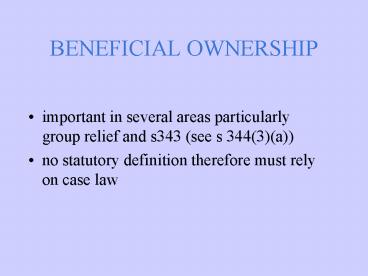BENEFICIAL OWNERSHIP - PowerPoint PPT Presentation
1 / 16
Title:
BENEFICIAL OWNERSHIP
Description:
(a) references to ownership shall be construed as references to beneficial ownership; ... for 5 years - in the event neither option was exercised and they lapsed ... – PowerPoint PPT presentation
Number of Views:886
Avg rating:3.0/5.0
Title: BENEFICIAL OWNERSHIP
1
BENEFICIAL OWNERSHIP
- important in several areas particularly group
relief and s343 (see s 344(3)(a)) - no statutory definition therefore must rely on
case law
2
344 Company reconstructions supplemental (3)
For the purposes of subsection (2) above (a)
references to ownership shall be construed as
references to beneficial ownership
3
Beneficial ownership "That means, I think, an
ownership which is not merely the legal ownership
by the mere fact of being on the register but the
right at least to some extent to deal with the
property as your own." Lord Justice Harman in
Wood Preservation Ltd v Prior 45 TC 112
4
BENEFICIAL OWNERSHIP
- Pritchard v M H Builders (Wilmslow) Ltd 45 TC 360
- Ayerst v C and K (Construction) Ltd 1975STC345
- Wood Preservation v Prior 45 TC 112
- J Sainsbury plc v OConnor 1991 STC 318
- J M S Timber Ltd v Quirk 48 TC 595
5
PRITCHARD v M H BUILDERS
- company went into liquidation - subsidiary formed
and trade and assets transferred to it - claimed to carry forward losses incurred by the
old company - held that the conditions of s343 could not be
satisfied when a company was in liquidation -
although the unsecured creditors had some rights
these did not amount to full beneficial ownership
and in any event the rights of the various
interested parties were very different before and
after the transfer to the subsidiary
6
Original company in liquidation (tax losses)
Purchaser
Transfer of trade and assets
Newly formed subsidiary
7
PRITCHARD v M H BUILDERS
- The additional comments made by the judge that
the rights of the parties before and after the
hive down are very different is difficult to
follow - on the face of it if someone does indeed have
beneficial ownership in liquidation it is hard to
see how that changes by virtue of a hive down - the point was finally dealt with in Ayerst some 6
years later
8
AYERST v C K
- company in liquidation set up subsidiary and
transferred trade and assets to it - claimed loss
carry forward - held the shareholders and creditors of a company
in liquidation were not the beneficial owners of
its assets therefore the provisions of s343 were
not satisfied - taxpayer accepted that Pritchard would have to be
overturned to allow it to succeed - held that beneficial ownership did not rest with
the creditors and shareholders
9
WOOD PRESERVATION
- contract dated March 25 for S to sell its shares
in W to B - offer accepted March 30 with conditions
- one was no dividends were to be declared
- another was that a supplier, which had granted
certain rights to S, would confirm by April 25
continuing these rights in favour of W - letter became unnecessary and condition was
formally waived on May 18 - on May 9 S transferred its trade to W
10
WOOD PRESERVATIONThe Key Issues
- was S still the beneficial owner of the shares in
W on May 9 when it transferred its trade thus
allowing its tax losses to be carried forward by
W? - taxpayer argued that contract was subject to a
condition precedent which was not satisfied until
May 18 Crown argued that S retained none of the
benefits of ownership after Mar 30 - Revenue won distinguished in Sainsbury
11
WOOD - THE REASONS
- judges concluded that Ss remaining (and very
restricted) rights did not amount to beneficial
ownership - influenced by the purpose of the legislation (to
allow closely associated companies to transfer
losses) and did not think that it was intended to
benefit Ss position - one judge (Donovan) observed that he was not
necessarily concluding that B had become the
beneficial owner at the critical time it is
possible for property to lack any beneficial
owner for a time
12
J SAINSBURY v OCONNOR
- Sainsbury agreed with another company to set up a
joint venture company to be owned 7030 - then realised that it would not be entitled to
group relief - agreed therefore to split ownership 7525 with S
having a put option and the other company having
a call option over 5 - the options could not be exercised for 5 years -
in the event neither option was exercised and
they lapsed
13
J SAINSBURY v OCONNORTHE ISSUES
- was S the beneficial owner of the full 75?
- did the option agreements amount to
arrangements within s 410? (Note - dealt with
under groups)
14
SAINSBURY BENEFICIAL OWNERSHIP
- the court held that S had all the key benefits of
ownership including dividend rights (although
under the option agreement any dividends were to
be deducted from the price to be received for the
shares) - Ss rights were not a mere legal shell (the
ground on which the Crown had succeeded in Wood
Preservation) - absence of dividend rights in Wood Preservation
was the key distinction - S therefore had beneficial ownership
15
J H S TIMBER v QUIRK
- company was in receivership
- receiver had correspondence with an intended
purchaser - hived down trade and assets to new subsidiary and
(one week later) sold it to the purchaser
16
J H S TIMBER v QUIRK
- held that the correspondence between the receiver
and the purchaser had resulted in a binding
contract to sell the subsidiary - the selling company did not therefore have
beneficial ownership of the subsidiary at the
time of the hive down - s 343 did not therefore apply and the losses did
not carry forward

